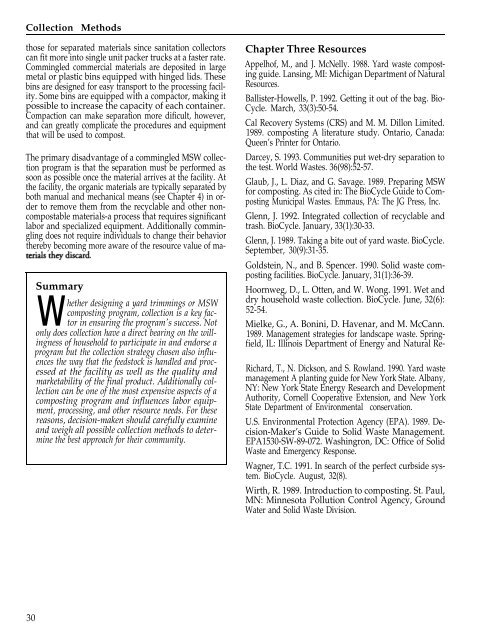Composting Yard Trimmings and Municipal Solid Waste
Composting Yard Trimmings and Municipal Solid Waste
Composting Yard Trimmings and Municipal Solid Waste
Create successful ePaper yourself
Turn your PDF publications into a flip-book with our unique Google optimized e-Paper software.
Collection Methods<br />
those for separated materials since sanitation collectors<br />
can fit more into single unit packer trucks at a faster rate.<br />
Commingled commercial materials are deposited in large<br />
metal or plastic bins equipped with hinged lids. These<br />
bins are designed for easy transport to the processing facility.<br />
Some bins are equipped with a compactor, making it<br />
possible to increase the capacity of each container.<br />
Compaction can make separation more dificult, however,<br />
<strong>and</strong> can greatly complicate the procedures <strong>and</strong> equipment<br />
that will be used to compost.<br />
The primary disadvantage of a commingled MSW collection<br />
program is that the separation must be performed as<br />
soon as possible once the material arrives at the facility. At<br />
the facility, the organic materials are typically separated by<br />
both manual <strong>and</strong> mechanical means (see Chapter 4) in order<br />
to remove them from the recyclable <strong>and</strong> other noncompostable<br />
materials-a process that requires significant<br />
labor <strong>and</strong> specialized equipment. Additionally commingling<br />
does not require individuals to change their behavior<br />
thereby becoming more aware of the resource value of ma-<br />
30<br />
terial they discard<br />
Summary<br />
whether designing a yard trimmings or MSW<br />
composting program, collection is a key factor<br />
in ensuring the program's success. Not<br />
only does collection have a direct bearing on the willingness<br />
of household to participate in <strong>and</strong> endorse a<br />
program but the collection strategy chosen also influences<br />
the way that the feedstock is h<strong>and</strong>led <strong>and</strong> processed<br />
at the facility as well as the quality <strong>and</strong><br />
marketability of the final product. Additionally collection<br />
can be one of the most expensive aspects of a<br />
composting program <strong>and</strong> influences labor equipment,<br />
processing, <strong>and</strong> other resource needs. For these<br />
reasons, decision-maken should carefully examine<br />
<strong>and</strong> weigh all possible collection methods to determine<br />
the best approach for their community.<br />
Chapter Three Resources<br />
Appelhof, M., <strong>and</strong> J. McNelly. 1988. <strong>Yard</strong> waste composting<br />
guide. Lansing, MI: Michigan Department of Natural<br />
Resources.<br />
Ballister-Howells, P. 1992. Getting it out of the bag. Bio-<br />
Cycle. March, 33(3):50-54.<br />
Cal Recovery Systems (CRS) <strong>and</strong> M. M. Dillon Limited.<br />
1989. composting A literature study. Ontario, Canada:<br />
Queen’s Printer for Ontario.<br />
Darcey, S. 1993. Communities put wet-dry separation to<br />
the test. World <strong>Waste</strong>s. 36(98):52-57.<br />
Glaub, J., L. Diaz, <strong>and</strong> G. Savage. 1989. Preparing MSW<br />
for composting. As cited in: The BioCycle Guide to <strong>Composting</strong><br />
<strong>Municipal</strong> <strong>Waste</strong>s. Emmaus, PA: The JG Press, Inc.<br />
Glenn, J. 1992. Integrated collection of recyclable <strong>and</strong><br />
trash. BioCycle. January, 33(1):30-33.<br />
Glenn, J. 1989. Taking a bite out of yard waste. BioCycle.<br />
September, 30(9):31-35.<br />
Goldstein, N., <strong>and</strong> B. Spencer. 1990. <strong>Solid</strong> waste composting<br />
facilities. BioCycle. January, 31(1):36-39.<br />
Hoornweg, D., L. Otten, <strong>and</strong> W. Wong. 1991. Wet <strong>and</strong><br />
dry household waste collection. BioCycle. June, 32(6):<br />
52-54.<br />
Mielke, G., A. Bonini, D. Havenar, <strong>and</strong> M. McCann.<br />
1989. Management strategies for l<strong>and</strong>scape waste. Springfield,<br />
IL: Illinois Department of Energy <strong>and</strong> Natural Re-<br />
Richard, T., N. Dickson, <strong>and</strong> S. Rowl<strong>and</strong>. 1990. <strong>Yard</strong> waste<br />
management A planting guide for New York State. Albany,<br />
NY: New York State Energy Research <strong>and</strong> Development<br />
Authority, Cornell Cooperative Extension, <strong>and</strong> New York<br />
State Department of Environmental conservation.<br />
U.S. Environmental Protection Agency (EPA). 1989. Decision-Maker’s<br />
Guide to <strong>Solid</strong> <strong>Waste</strong> Management.<br />
EPA1530-SW-89-072. Washingron, DC: Office of <strong>Solid</strong><br />
<strong>Waste</strong> <strong>and</strong> Emergency Response.<br />
Wagner, T.C. 1991. In search of the perfect curbside system.<br />
BioCycle. August, 32(8).<br />
Wirth, R. 1989. Introduction to composting. St. Paul,<br />
MN: Minnesota Pollution Control Agency, Ground<br />
Water <strong>and</strong> <strong>Solid</strong> <strong>Waste</strong> Division.

















